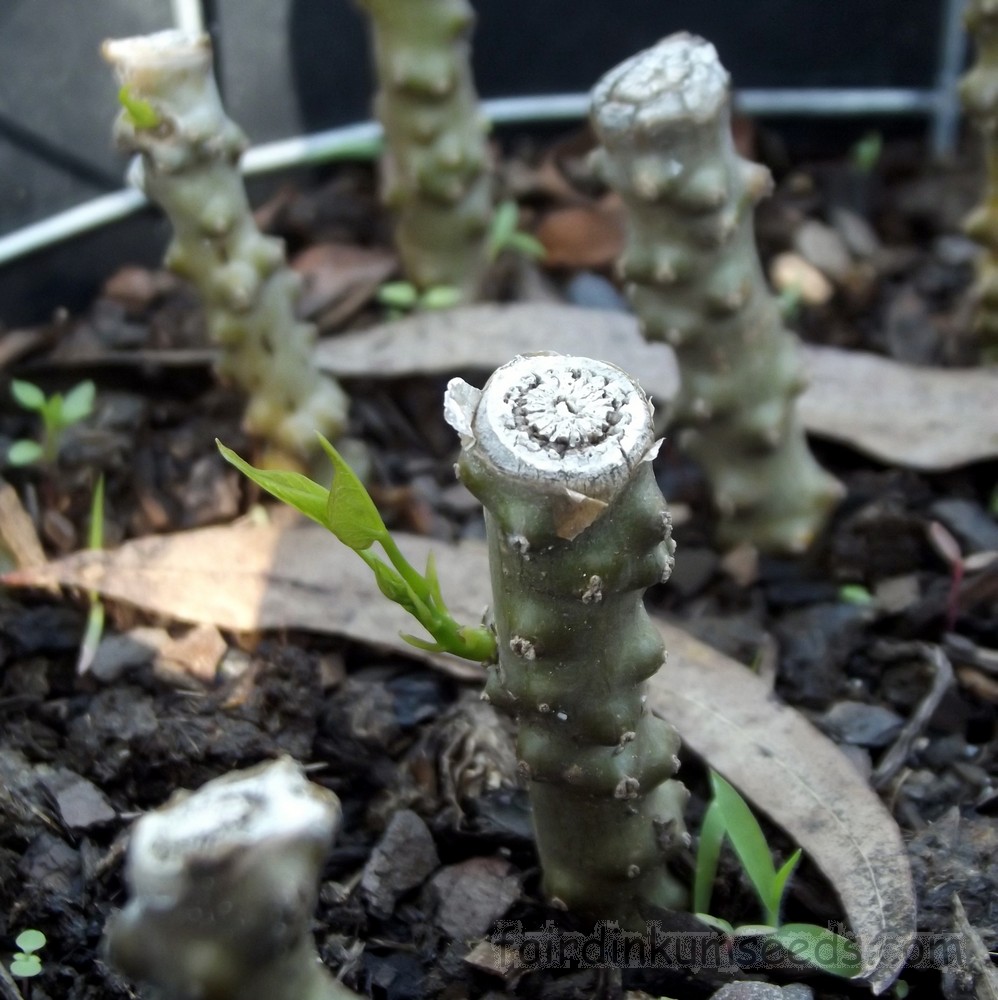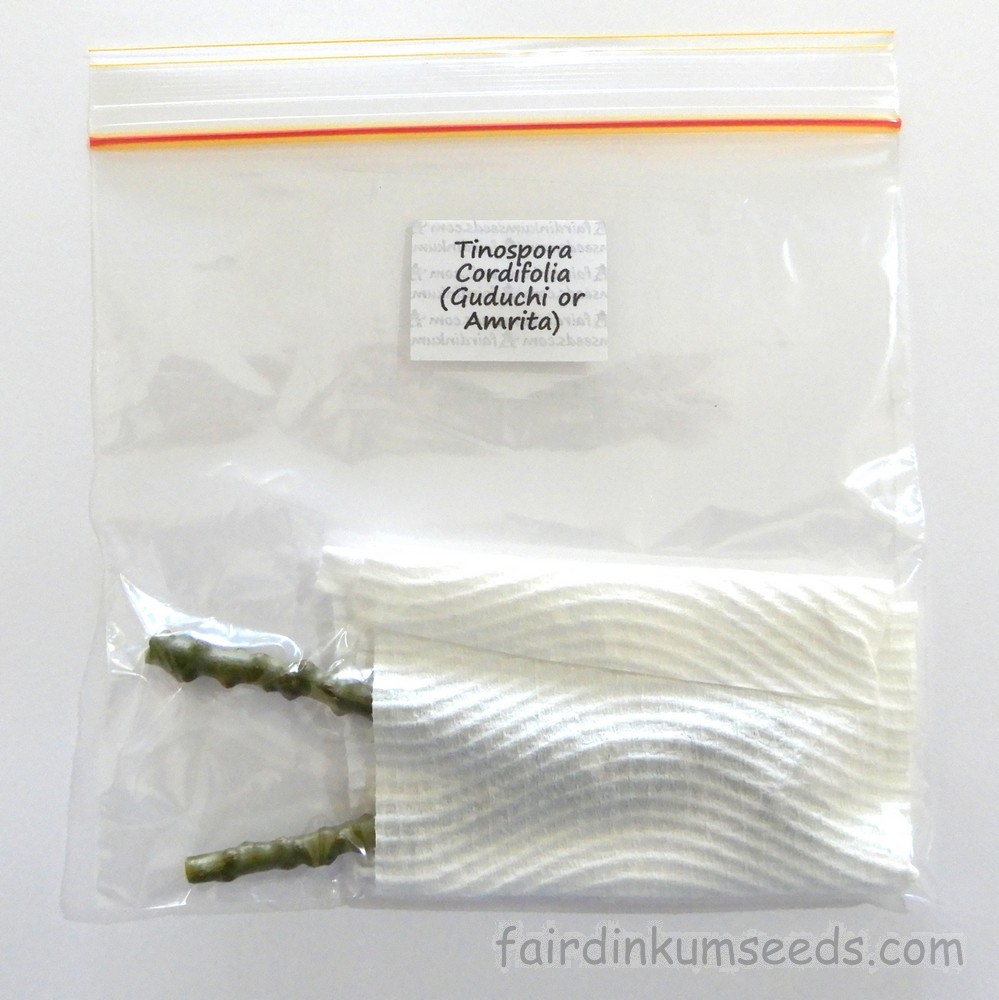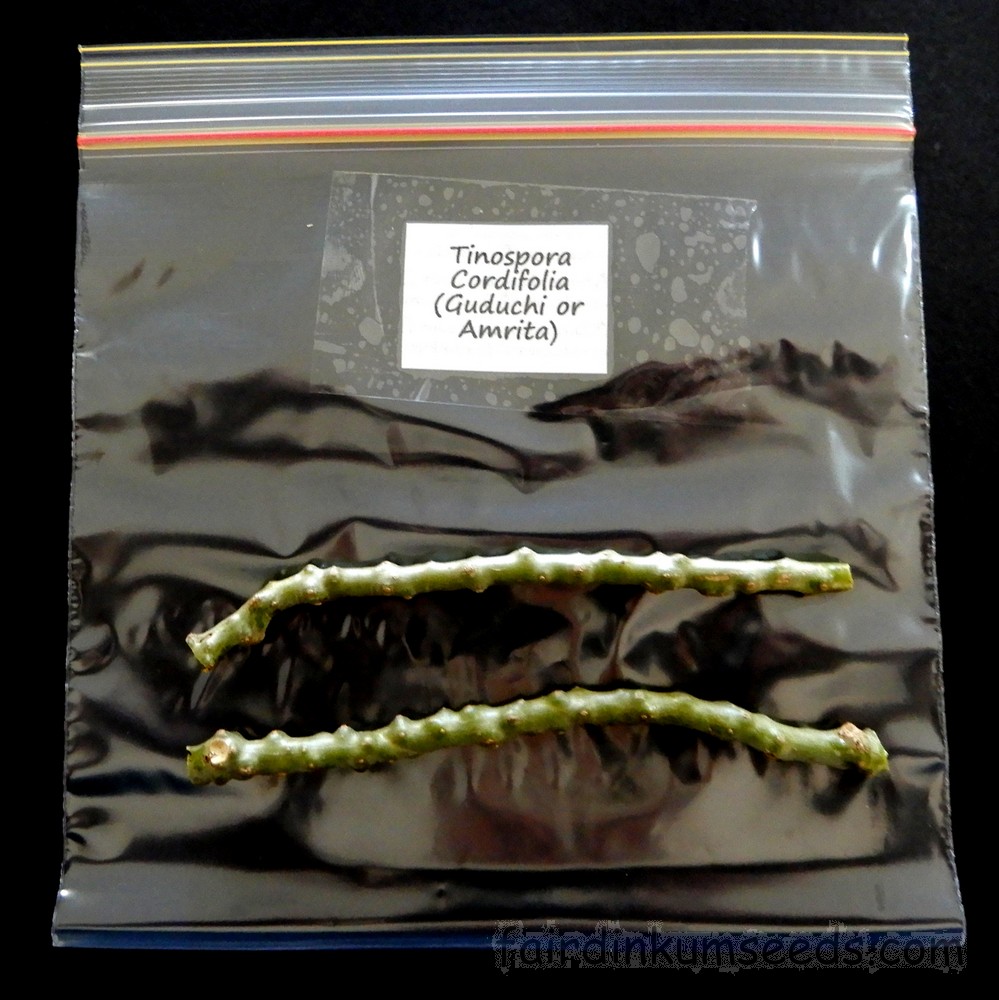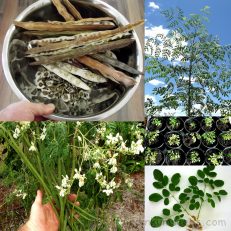Please read text!
Tinospora Cordifolia Guduchi Amrita Cuttings
Packet containing 2x small fresh unrooted cuttings!
They will be wrapped in moist paper, posted worldwide in a bubble mailer, ready to plant on arrival at your place.
All you do is get some nice sandy well-draining soil mix, stick them in it buried halfway up the stems.
Water well and wait.
Should be shooting anywhere from 1-4months(climate dependent) and once they send up that first shoot growth is very rapid. They may die off completely above the soil line during this time later reshooting from below the soil line so if they disappear don’t stress. Every single node/bump has the ability to send up a shoot.
There are so many things to say about this fella, and I am super excited to be able to share some around!
But, I better get the names out of the way first.
I believe Tinospora cordifolia is the current correct botanic name for this fella, but it is also sometimes know as Campylus sinensis, Cocculus tomentosus, Menispermum cordifolium, Menispermum malabaricum, Menispermum tomentosum, Tinospora malabarica, Tinspora tomentosa, Chasmanthera cordifolia, Chasmanthera cordifolia, Cocculus convolvulaceus, Cocculus cordifolius, Cocculus verrucosus, Menispermum cordifolium, Menispermum glabrum, Tinospora convolvulacea, Tinospora cordifolia var. congesta, Tinospora fosbergii, and Tinospora verrucosa.
In many places the name “Tinospora cordifolia” is incorrectly used to describe all the very closely related medicinal species that are used in the same way, and I have seen that name misapplied to both pictures, and in medicinal studies to Cocculus malabaricus, Menispermum crispum, Tinospora crispa, Tinospora malabarica var scabridula, Tinospora malabarica var tomentosa, Tinospora mastersii, Tinospora nudiflora, Tinospora nudiflora sensu, Tinospora sinensis, Tinospora thorelii and no doubt many others.
It seems the whole family is used the same way interchangeably, with this fella, Tinospora cordifolia being considered “divine” and the most potent and powerful of the lot.
I believe it stems from poor translation of local dialects, and the very minor differences between similar medicinal species being lost in translation somewhere between the traditional medical practitioner from the rural village, the translator they picked up in the nearest city, and the visiting scientists who are experts at chemical analysis, but not always great botanists.
It is know most commonly as guduchi or amrita, but also acaci, acanamirta tailam, agniballi, akaca k karutan, akaca valli, akaci, akaya-valli, amarai, amirta-k-koti, amirtai, amirtavalli, amritavalli, amritvel, amrtahva, amrtaka, amrtalata, amrtasamjna, amrtavalli, amrutaballi, amrutha balli, amruthu, amutai, anantai, arukanci, avali, bandaul pich, boraphet, cakra, cakrahva, cakrangi, cancavi, cankam, cati, cchinna, cchinnaja, cchinnaruha, ching cha chali, chinna, chinnaruha, chitamrith, chittamruthu, cilanti, cinnam, cinnarukam, cinnodbhava, cintil, civetai, cukkumam, cuveta kantam, dussiramu, galac, galo, galoci, garo, geloy, giloya, gllow, gudach, guduchi, guduchi krautertee, gulancha, gul bel, gulbel, gulochi, guluchi, guluncha, gulvel, gurch, gurcha, gurjo, guruc, heart-leaved tinospora, heart leaf, heartleaved moonseed, heart leaved moonseed, hoguni lot, Indian tinospora, irecaki, jivanti, jivantika, jvara arihi, kacci, kuan jin teng, kunali, kundali, kuntali, mati y ampal, matucciram, matu parunikai, moonseed, moon seed, nateyam, ningthou khongli, pakanrai, parivai, paruni, patala mulam, pattikai, pittagni, ponra valli, porra valli, rasakinda, sat gilo, shaguni lata, shindil kodi, sle tres, soma valli, somavalli, tantirakam, TC, TCRE, TCRET, theisawntlung, tiktaparvan, tinofolin, tinospora, tinospora gulancha, tippa teega, tippatige, tippatigo, vaccatani, vacikaram, vajra, valli k kantam, vapamatu, vatsadani, vatsahani, vayamatu, vicali, xin ye qing niu dan, zet al buta, zet al roomi and bitter grape.
This huge amount of common names is due to it being grown and used as a medicine in a huge amount of places. All through India, West Bengal, Bangladesh, Myanmar, Pakistan, Sri Lanka, Laos, Thailand, Cambodia, Vietnam, Malaysia, Singapore, Tajikistan, Hong Kong, China, Korea, Japan, Saudi Arabia, Africa, and pretty much every other place that has a warmish climate.
I grow it strictly as an ornamental, and I reckon it looks really cool.
I can’t, don’t and won’t offer any medical advice, but I can tell you it has been used for centuries in TCM, Ayurveda, Tibetan medicine as both a treatment and preventative for cancer, allergy, diabetes, inflammation, immune system support, neurological issues, high cholesterol, rhinitis, upset stomach, gout, lymphoma, liver disease, rheumatoid arthritis, hepatitis, peptic ulcer disease, fever, gonorrhea, syphilis, diarrhea, dysentery, jaundice, sore throat, bronchitis, tuberculosis, diphtheria, boils and carbuncles, skin diseases, leprosy, gastric reflux, pain, venomous bites and stings from insects, scorpions, snakes and spiders, as a powerful aphrodisiac, and to increase sperm production.
It is believed the main medical benefits come from the “endophytic fungi” that live inside the plants tissues, not so much the actual plant tissue.
Apparently, these organisms colonize the living internal tissues of the host(Tinosporum cordifolia) without causing it any harmful effects.
In actual fact these fungi produce chemicals that are not only potential medicines for us humans, they are insecticidal as well, and a recent study shows that it is very effective against Oriental leafworm moth ~ Spodoptera litura.
There are at least 29 endophytic fungi that inhabit the tissue of this species, and numerous naturally occurring chemicals have also been found including berberine, choline, columbin, jatrorhizine, palmatine, phenylpropene disaccharides, tembeterine, tinocordifolioside, tinosporal, tinosporaside, tinosporic acid, and tinosporon.
It is a very interesting species and if you want to read more about it there have been thousands of studies done over the years.
Google scholar brings up more than 13,000 results for this species!
Anyway, I reckon it’s cool so I am growing it, and now you know absolutely everything I do too.
Please note.
Minor fungal attack and rot on the cut ends and damaged areas of the cuttings is normal and completely unavoidable as the environment needed for successful live arrival of the cuttings, is also the same steamy sweaty wet conditions that fungi and bacteria thrive in. I can not send the plant dry as dry = dead with this fella.
Wet paper and damaged plant matter in the hot steamy post = fungal and bacterial growth, just how it is.
I could use chemicals and/or acids to inhibit this but I’m not really a fan of that, and most will also corrode the plant tissue as bad if not worse, making the whole excercise real world pointless…
Regardless it isn’t necessary as the effect of these organisms is minor and the dodgy looks don’t affect the survival rate.
Rest assured as soon as you remove the cutting from the bag and unwrap the wet paper the conditions are no longer suited for any dodgy fungi and bacterial growth that has accumulated in transit. Give it a gentle rinse in clean water (taking note of which end is up!) and any that remains immediately dies and becomes fertilizer for the recovering and reshooting cutting.
It may/will smell and look kinda dodgy on arrival the same way a bag of lettuce would look dodgy after a long rough journey in the mail. Regardless, it will grow fine and all you need do is plant the cuttings with the paper end buried half underground in a well-draining sandy soil mix, and wait.
That is literally all I do and I get 100% success with roots and shoots appearing anywhere from a month to 4months later, depending on the weather at the time. A decade ago I test shipped to a dozen worldwide locations and had friends return ship to me, to give a worst case scenario DOUBLE international transit time. I do this with everything I am thinking about selling and even then I still averaged 70% survival rate with this fella. With 2 cuttings in each order instead of 1, I figure it’s pretty hard to go wrong.
Warm climates are best, though once it’s big and healthy you can always just move it inside during the colder months. I do know a dude in Russia and another in Germany that grow it inside under led lights, but yeah, I can’t offer any advice as I don’t do it myself.
Please don’t email me and tell me they look dodgy on arrival as all I can tell you is, yeah, they probably smelled pretty bad when you unwrapped them too…
Regardless just follow the basic instructions above and they will grow as well for you as they have for the 100’s of other customers in locations all over the world. Hard to fail with this one.
Everything I know, is in the text above. Everything else it is probably best to just Google it because there is so much info out there, you could spend literally years just reading about this amazing species.
But why do that when you can just buy a couple of cuttings and start growing it yourself!
Grown by me and the Mrs organically, no chems, no nasties, no dramas!!!





